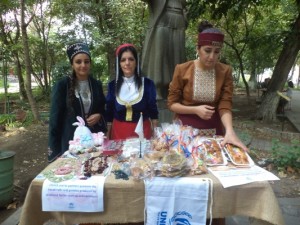Syrian-Armenian women love to participate in exhibition-sales

We sat down for an interview with two Syrian-Armenian girls named Ani, including Ani Artinian and Ani Terterian. We met them at the recent Rural Life and Traditions Festival that also brought together Syrian-Armenians living in Armenia, writes womennet.am.
Ani Artinian was participating with her son, Arto Kafagian.
Ani Artinian: My husband and our three sons have been living in Armenia for the past three years now. When we were living in Aleppo, we would make beads and sell them. Later, I took culinary courses in Gaza, mastered the culinary arts and earned more or less by selling pastry. After settling in Armenia, my husband found a job. He is a wielder by profession. Thanks to my two professions, I can ease the burden. It’s my pleasure to participate in the exhibition-sales, and my sons help me. I spend most of my time making beads and presenting my handmade items at the Vernisazh market. I have no complaints. I take orders and make pastry, dishes with meat and handmade items,” says Ani, adding that such events are a great help for Syrian-Armenians.
Ani Artinian’s goal is to help her sons achieve their goals. If they don’t get accepted to a university, at least they have the aspiration to become master craftsmen. The family doesn’t want to go back to Syria and aren’t even considering it. “We were born and raised in Syria, but we’ll die here,” says Ani.
The festival had also brought our longtime acquaintances, Yoland and Raffi Rshtuni, whose pavilion showcased the juicy and tasty pastry and various kinds of biscuits.
Dressed in the embroidered national costume of Marash, Ani Terterian, 20, presented a variety of jewels, oriental pastry and handmade items. Ani and her sisters loved learning about the embroidery of Marash when they lived in Syria. They were taught by their mother, who would embroider and sew the embroidered costumes of Marash with her daughters. They came to the festival in those costumes.
Alongside studying in the Department of Physiotherapy at the Armenian State Institute of Physical Culture of Yerevan, Ani also helps her mother and sisters make pastry. Although she is very busy during the day, she always finds time to make jewels. There is quite a high demand for elegant and tasteful chains, bracelets and soft toys, and that excites Ani. True, the family doesn’t have orders for costumes yet and the visitors simply admire the costumes of the mother and her daughters, who knows, perhaps one day there is a demand for those costumes or the embroidered costumes of Marash.
“My family and I have decided to create a factory for handmade items. I also want to sell jewels. I have to support my family somehow, right?” says Ani.
The participation of Syrian-Armenians in such festivals would perhaps be impossible, if it wasn’t for the support from the UNHCR, as well as several local and international organizations.
“Such festivals are the result of the joint efforts of dozens of organizations, including organizations supporting Syrian-Armenians,” says Foreign Relations Coordinator of the UNHCR Anahit Hayrapetyan and adds: “The active participation of Syrian-Armenians in festivals and exhibitions is commendable. They get excited when they see progress, and evidence of that is the smile on the face of a Syrian-Armenian. As for us, we’re happy to make our contribution. They didn’t have competition in Syria, but they do in Armenia, and that stimulates them to be well aware of the legislation and the demand in the market. So, they improve the quality of their products and make them look better, adapting them to the local market. The UNHCR and its partners are always ready to support and encourage them in all their initiatives.”
Anush Nersisyan




 Արևելահայերեն
Արևելահայերեն Արևմտահայերեն
Արևմտահայերեն Русский
Русский






